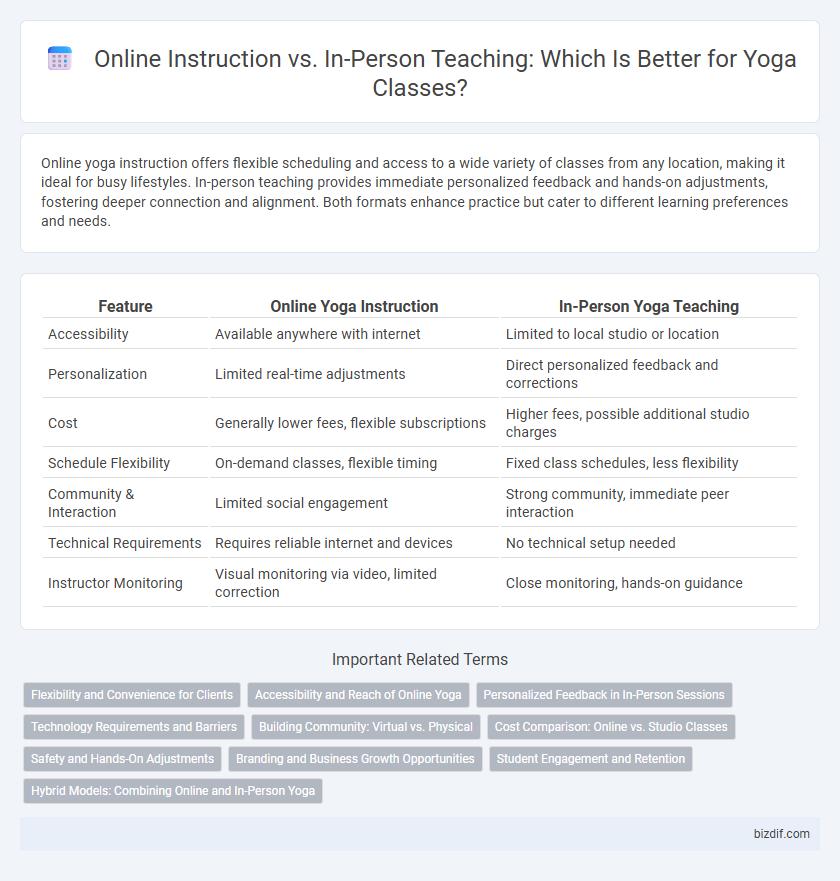Online yoga instruction offers flexible scheduling and access to a wide variety of classes from any location, making it ideal for busy lifestyles. In-person teaching provides immediate personalized feedback and hands-on adjustments, fostering deeper connection and alignment. Both formats enhance practice but cater to different learning preferences and needs.
Table of Comparison
| Feature | Online Yoga Instruction | In-Person Yoga Teaching |
|---|---|---|
| Accessibility | Available anywhere with internet | Limited to local studio or location |
| Personalization | Limited real-time adjustments | Direct personalized feedback and corrections |
| Cost | Generally lower fees, flexible subscriptions | Higher fees, possible additional studio charges |
| Schedule Flexibility | On-demand classes, flexible timing | Fixed class schedules, less flexibility |
| Community & Interaction | Limited social engagement | Strong community, immediate peer interaction |
| Technical Requirements | Requires reliable internet and devices | No technical setup needed |
| Instructor Monitoring | Visual monitoring via video, limited correction | Close monitoring, hands-on guidance |
Flexibility and Convenience for Clients
Online yoga instruction offers unmatched flexibility, allowing clients to practice anytime and anywhere, fitting sessions seamlessly into busy schedules. In-person teaching provides real-time feedback and personalized adjustments, yet requires clients to adhere to specific locations and class times. The convenience of virtual classes enhances accessibility, making yoga practice more adaptable to individual lifestyle needs.
Accessibility and Reach of Online Yoga
Online yoga instruction significantly enhances accessibility by allowing students from diverse geographic locations to participate without travel constraints, expanding reach beyond local communities. Digital platforms enable real-time interaction and recorded sessions, accommodating varying schedules and skill levels for a personalized practice. This virtual format democratizes yoga education, offering affordable options with diverse instructors, which physical studios may not always provide.
Personalized Feedback in In-Person Sessions
In-person yoga instruction offers unparalleled personalized feedback, allowing instructors to observe subtle body alignments and provide immediate corrections tailored to individual needs. This direct interaction enhances posture refinement, reduces injury risk, and accelerates skill development more effectively than online sessions. The tactile and visual cues available in face-to-face classes significantly improve the overall learning experience and student engagement.
Technology Requirements and Barriers
Online yoga instruction demands reliable high-speed internet, a quality camera, and a suitable device to ensure clear visuals and audio, contrasting with minimal technology needs for in-person teaching. Barriers for online classes include technical difficulties and limited ability to correct posture in real-time, which can affect the quality of instruction. In-person teaching provides direct physical adjustments and immediate feedback, eliminating many technology-related challenges faced by virtual sessions.
Building Community: Virtual vs. Physical
Online yoga instruction enables global community building by connecting practitioners across diverse locations through interactive platforms and live sessions. In-person teaching fosters immediate social bonding and shared energy, enhancing a strong, local support network through face-to-face interactions. Both methods uniquely contribute to building a vibrant yoga community with varying degrees of intimacy and accessibility.
Cost Comparison: Online vs. Studio Classes
Online yoga instruction typically offers a more cost-effective alternative to in-person studio classes, with prices averaging 30-50% lower due to reduced overhead expenses. Studio classes often include additional fees such as membership, equipment use, and facility maintenance that increase overall costs. Many practitioners find online subscriptions and pay-per-class options provide budget-friendly access to diverse teaching styles without sacrificing instructional quality.
Safety and Hands-On Adjustments
Online yoga instruction enhances safety by eliminating physical contact and reducing the risk of injury during practice. In-person teaching allows for hands-on adjustments that improve alignment and prevent strain, offering personalized corrections that online classes cannot replicate. Balancing virtual convenience with the tactile benefits of studio sessions ensures optimal safety and effective posture refinement.
Branding and Business Growth Opportunities
Online yoga instruction expands brand visibility by reaching a global audience, leveraging digital marketing and social media to attract diverse clients. In-person teaching fosters stronger community connections and personalized experiences, enhancing client retention and word-of-mouth referrals. Combining both methods optimizes business growth by diversifying revenue streams and building a versatile, recognizable brand.
Student Engagement and Retention
Online yoga instruction offers flexible scheduling and access to a diverse range of teaching styles, which can boost student engagement through multimedia resources and real-time feedback. In-person teaching fosters a deeper sense of community and immediate physical adjustments, enhancing retention by creating stronger personal connections and accountability. Combining both methods can optimize student interaction and long-term commitment, leveraging technology while maintaining the benefits of face-to-face guidance.
Hybrid Models: Combining Online and In-Person Yoga
Hybrid yoga models integrate the flexibility of online instruction with the personalized guidance of in-person teaching, enhancing accessibility and learner engagement. These models leverage live streaming technology and interactive platforms, allowing students to participate from anywhere while benefiting from real-time feedback and community interaction. Combining virtual and physical sessions optimizes skill development, caters to diverse learning preferences, and supports consistent practice regardless of geographic constraints.
Online instruction vs In-person teaching Infographic

 bizdif.com
bizdif.com